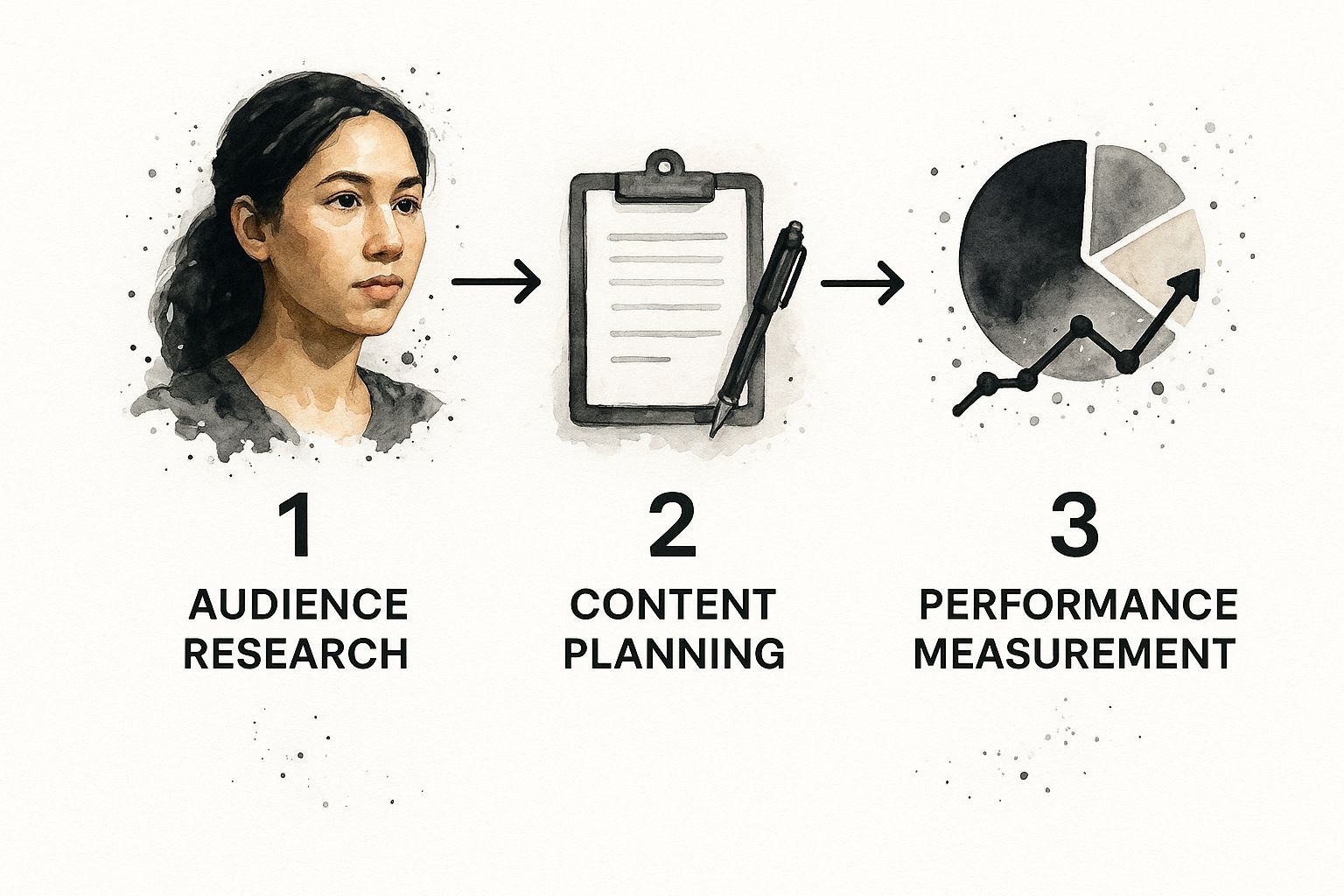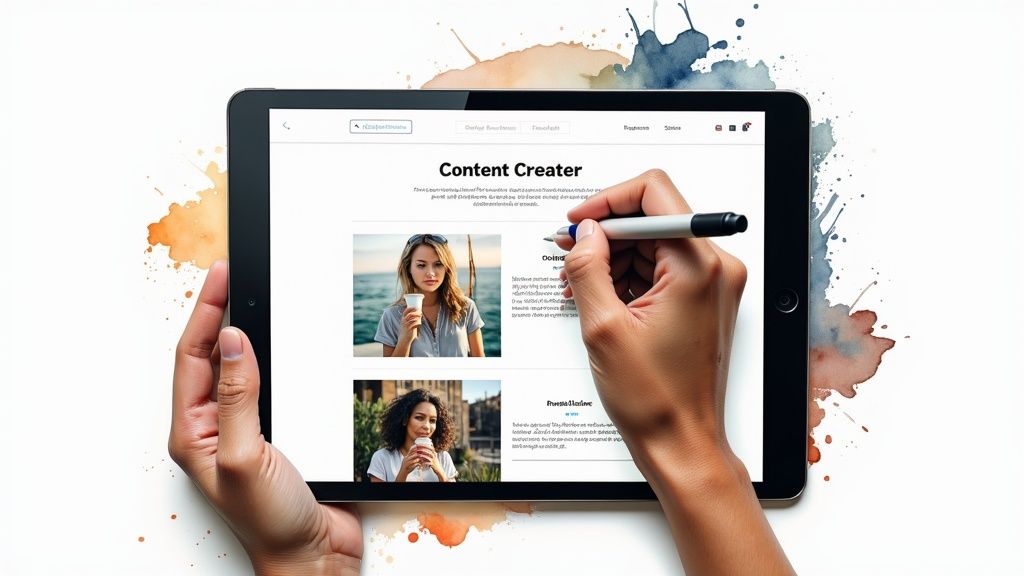An agency content strategy is more than just a plan; it’s a detailed blueprint for creating and distributing content that actually pulls in high-value clients. It’s about ditching the random acts of marketing and building a predictable system for growth. Every single piece of content should be tied directly to a business goal, whether that’s generating leads or cementing your agency as an industry authority.
Building a Content Engine That Actually Drives Growth
Let’s be honest, the old ‘publish and pray’ model is dead. The agencies I see winning today aren't just creating a collection of blog posts—they're building predictable content engines. This means every part of your agency content strategy is anchored to real business outcomes, like getting more qualified marketing leads or becoming the undisputed expert in your niche.
The heart of this engine is a deep, almost obsessive, understanding of your audience. I’m not talking about those vague, dusty personas. I mean defining your ideal client profile with painful precision. What are their biggest headaches? What questions are they Googling at 2 a.m.? Your content has to be the answer they’re looking for.
Define Your Strategic Pillars
Before you even think about writing a single word, you need to lock down the core components of your strategy. A solid content program is built on a few essential pillars that will guide every decision you make. This clarity is what separates a focused, effective strategy from just creating "stuff."
Here's what you need to nail down:
- Business Objectives: What's the end game? Are you trying to get more demo requests? Shorten the sales cycle? Increase brand searches? Your content goals have to directly fuel your agency's main business objectives.
- Ideal Client Profile (ICP): Go way beyond basic demographics. You need to map out their specific pain points, their day-to-day workflow, and even the exact words they use to describe their problems. This is absolute gold for creating content that connects.
- Competitive Landscape: Take a hard look at what your competitors are doing right—and, more importantly, where they’re dropping the ball. Look for the content gaps you can swoop in and own, or find topics you can cover with far more depth and real-world insight.
- Brand Voice and Positioning: How do you want to come across? Are you the approachable, friendly expert? The sharp, data-driven analyst? Or the bold, disruptive innovator? A consistent voice is critical for building trust and making your brand memorable.
To pull this all together, it really helps to use a proven content strategy framework. This gives your efforts structure and ensures you’re building a cohesive program from the ground up, not just winging it.
To help you organize these concepts, here’s a quick summary of the core pillars that should underpin your content program.
Core Components of a Modern Content Strategy
| Component | Objective | Key Action |
|---|---|---|
| Business Objectives | Align content with agency growth goals. | Define specific, measurable outcomes (e.g., increase MQLs by 20%). |
| Ideal Client Profile | Create deeply resonant content. | Map out client pain points, workflows, and language. |
| Competitive Analysis | Identify opportunities and gaps. | Analyze competitor content to find underserved topics. |
| Brand Voice | Build a recognizable, trusted brand. | Define and document your unique tone and positioning. |
Having these components clearly defined is the difference between a strategy that works and one that just creates noise.
The most common reason content strategies fail is a lack of commitment and a detailed plan. Creating a calendar and establishing a rhythm turns good intentions into consistent execution, which is the only way to see long-term results.
Visualizing the Content Workflow
To see how these pillars come together in practice, it’s useful to visualize the entire process. This isn't just about the "create" step; it's a full cycle.
This simple infographic lays out the core workflow of a successful agency content strategy.

As you can see, success starts way before you hit "publish." It begins with that deep audience understanding and ends with a rigorous analysis of what actually worked.
The investment in this space is just staggering. By 2025, the content marketing industry is expected to be worth an incredible $107 billion globally. That alone tells you how critical this is. With nearly 84% of companies now running a defined content marketing strategy, agencies that don't have a coherent plan are going to be completely drowned out.
This isn't just about creating content; it's about building a repeatable system that consistently attracts and converts the clients you actually want. For more practical advice on building out your agency’s presence, you’ll find some great resources over on the rebelgrowth.com/blog.
Let's be real: AI is no longer just some tech buzzword. For any modern agency, it's a fundamental part of the toolkit. But the real win isn't about replacing your team—it's about giving them a creative co-pilot.
This is how you shift your agency's content strategy from a manual, time-sucking grind into a hyper-efficient operation.
The trick is to think beyond just generating a block of text. The smartest agencies I know are using AI for the heavy lifting: deep audience research, building out data-backed topic clusters, and optimizing their entire content library at scale. It’s all about freeing up your team to focus on what people do best—high-level strategy and real, human creativity.
Supercharge Your Ideation and Research
Honestly, the most powerful way to use AI in your content strategy comes way before you even think about a headline. Treat it like a tireless research assistant that can uncover hidden opportunities and validate your creative gut feelings with cold, hard data.
Here are a few ways to get started that have a huge impact:
- Mine for Audience Pain Points: Get transcripts from sales calls or a CSV of customer reviews and feed them to an AI tool. Ask it to pull out recurring pain points, common questions, and the exact words your clients use. This stuff is absolute gold for writing content that actually connects.
- Run a Competitor Gap Analysis: Give it the blog URLs of your top three competitors. Then, prompt the AI to analyze their main content pillars and pinpoint underserved topics or unique angles you can swoop in and own.
- Build Data-Driven Topic Clusters: Stop guessing which topics belong together. Ask an AI to act as a senior SEO specialist. Hand it a core topic like "B2B lead generation" and ask for a list of semantically related sub-topics. This is the foundation for a rock-solid pillar page and cluster model.
Integrating AI Into Your Content Workflow
Bringing AI into the mix needs structure, not a free-for-all. To keep quality high and your brand voice consistent, you need to set up clear workflows and rules for your team. This is what keeps AI from diluting your agency's unique voice.
First off, define your "human-in-the-loop" checkpoints. For instance, AI can spit out the first draft of an outline, but a human strategist must refine it to inject your agency’s unique point of view. AI can suggest a dozen meta descriptions, but a human needs to review them for brand voice and emotional punch.
This screenshot shows a simple but powerful prompt asking an AI tool to brainstorm blog post ideas based on a very specific client problem.

Notice how the prompt gives the AI a clear role ("act as a content strategist") and specific context ("a B2B SaaS company struggling with user retention"). This kind of detail is what separates useful, targeted outputs from generic, unusable suggestions.
Pro-Tip: Treat your AI prompts like you would a creative brief for a junior copywriter. The more context, constraints, and background info you provide, the better the output. Vague inputs will always get you vague results.
The move toward AI isn't just a trend; it's a tidal wave. By 2025, a massive 90% of content marketers plan to use AI, a huge leap from 64.7% in 2023. Tools like ChatGPT are at the forefront, helping with everything from outlining (71.7%) to brainstorming (68%).
But here’s the kicker: this isn't just about speed. It's about results. Only 21.5% of AI users report that their strategies underperform, compared to 36.2% of non-users. The data on content marketing performance makes it pretty clear that AI has a real, tangible impact.
Building Your Agency's AI Stack
Choosing the right tools is critical. You don't need a dozen different subscriptions; you need a tight, curated stack that solves specific problems in your workflow.
I recommend a layered approach:
- Generative AI for Ideation: A foundational tool like ChatGPT or Claude for all your brainstorming, outlining, and first-drafting needs.
- SEO-Focused AI Platform: A specialized tool like SurferSEO or MarketMuse that uses AI to analyze the SERPs, find keyword opportunities, and help you optimize content for search.
- AI-Powered Editing Tool: A platform like Grammarly or Writer.com to enforce brand voice, check for plagiarism, and maintain grammatical consistency across your entire team.
When you build a thoughtful AI stack and create smart workflows around it, you turn AI from a simple gadget into a true strategic partner. This lets your team do what they were hired for: the high-value, creative, and strategic work that actually drives results for your clients.
Alright, let's get into the heart of it. You've got your strategy mapped out and your AI co-pilot is ready to go. Now it's time to actually create the content—the stuff that will make high-value clients sit up and take notice.
This is where the rubber meets the road, turning your planning docs into tangible assets that pull in the right kind of business. We’re not just chasing Google rankings here. The real goal is to forge a connection with the decision-makers you want to work with.
Forget generic blog posts. High-value clients are swimming in information and have zero time for fluff. They respond to content that solves a real, painful problem, offers a perspective they haven't heard before, or gives them data they can't get anywhere else.
Choosing Formats That Drive Decisions
The content formats you pick should be a direct line to your business goals and where your ideal client is in their buying process. Blog posts are great for getting on their radar, but decision-makers usually need something more substantial before they'll even think about booking a call.
From my experience, a few formats consistently crush it for agencies targeting sophisticated clients:
- Compelling Case Studies: These aren't just project reports. A killer case study tells a story of transformation. You need to detail the client's problem, lay out your strategic solution, and—most importantly—show the measurable business results you delivered. Think of it as a hero's journey: your client is the hero, and you're the trusted guide who helped them win.
- Original Research Reports: Nothing builds authority faster than creating your own data. Surveying your industry on a hot-button issue and publishing the results instantly positions you as a thought leader. This kind of content is a magnet for backlinks and a powerhouse for lead generation, especially when you put it behind a form.
- Authoritative White Papers: Use these to go deep on complex industry challenges. A white paper should be your agency's definitive take on a topic, packed with data, sharp analysis, and a clear point of view that screams strategic expertise.
- High-Engagement Webinars: Webinars give you a direct, real-time line to your audience. They're perfect for walking prospects through a complicated framework, presenting your latest research findings, and building rapport in a live Q&A.
The most powerful content you can create is the kind that makes prospects feel smarter and more capable. Your job is to educate and empower, not just sell. Nail that, and the sale becomes the natural next step.
Mapping Content to the Buyer’s Journey
Throwing content at the wall to see what sticks is a massive waste of time and money. A smarter strategy is to map specific assets to each stage of the buyer's journey. This makes sure you're delivering the right message at the right time, guiding prospects smoothly down the path to becoming a client.
Think of it as creating a guided tour, from "I have a problem" to "You're the solution."
The "Just Looking" Stage (Top of Funnel)
At this point, your prospect knows they have a problem, but they might not have a name for it yet or know what solutions are out there. Your content here should be purely educational and helpful. No sales pitches.
- Your Goal: Attract a wide but relevant audience and start building some brand recognition.
- What to Create: SEO-driven blog posts that answer common questions, quick-hit videos for social media, and insightful commentary on industry news.
The "Kicking the Tires" Stage (Middle of Funnel)
Now your prospect is in research mode. They're actively comparing different approaches and checking out various agencies. Your content needs to prove why your way of doing things is the best.
- Your Goal: Build trust and show off what makes your agency's expertise unique.
- What to Create: Detailed "how-to" guides, webinars that break down your process, in-depth case studies, and comparison pieces that pit your approach against the alternatives.
The "Ready to Buy" Stage (Bottom of Funnel)
This is it. The prospect is ready to pick a partner. They just need that final piece of reassurance that your agency is the right—and safest—bet.
- Your Goal: Convert the prospect into a solid lead and seal the deal.
- What to Create: Gated original research, detailed service pages that leave no questions unanswered, personalized demo videos, and glowing client testimonials.
By creating assets for each stage, you're not just publishing content; you're building an ecosystem. It’s a system designed to nurture leads from their very first click all the way to a signed contract. This turns your content from a simple marketing task into your agency's most effective, 24/7 salesperson.
Amplifying Your Content Beyond Your Website

Hitting “publish” isn’t the finish line. It’s the starting gun. A brilliant article or case study that nobody sees is a massive waste of effort and opportunity. For any agency content strategy to actually work, distribution has to be treated with the same seriousness as creation.
The old checklist of just posting to your social channels doesn't cut it anymore. Not even close. A modern approach demands a deliberate, multi-channel distribution plan to squeeze every last drop of value from your content. The goal is to get your best work in front of the right people, wherever they are.
Moving Beyond Your Owned Channels
Your website and blog are your home base, but the real growth happens when you strategically push your content out into the wider digital ecosystem. This means finding the platforms where your ideal clients already spend their time and, more importantly, trust the information they find there.
A few key tactics can dramatically extend your reach:
- Targeted Email Outreach: This isn't about spamming a list. It’s about identifying specific journalists, influencers, or even non-competing businesses whose audience would find your content genuinely useful. A personalized email explaining why it's relevant to them can land you shares, mentions, and valuable backlinks.
- Building Syndication Partnerships: Look for respected industry publications that accept contributed content. Getting your articles republished on these sites (with a canonical link back to the original, of course) exposes your expertise to a brand new, highly relevant audience.
- Empowering Team Advocacy: Your team members are your most authentic advocates. Encourage them to share content on their professional networks, like LinkedIn. The truth is, individual experts often get far more engagement and visibility than official company pages do.
The success of your content is not determined by how well it’s written, but by how well it’s distributed. An average piece with great promotion will always outperform a masterpiece that's left to sit on your blog.
The Art of Strategic Repurposing
Let's be honest: not everyone wants to read a 2,000-word blog post. Strategic repurposing is about taking one significant "cornerstone" piece of content and atomizing it into an entire ecosystem of smaller assets. This ensures you’re meeting your audience on their preferred platforms and in their preferred formats.
This approach maximizes your investment. One deep research report can fuel your content calendar for weeks, if not months. It’s all about working smarter, not harder.
Creating a Content Ecosystem
Think of your best, most comprehensive piece of content as the sun. Everything else should orbit around it, pulling from its central insights.
Let's take a cornerstone asset as an example: an in-depth guide on creating high-converting landing pages.
You can then spin this single guide into a whole universe of smaller assets:
- Micro-Videos for Social Media: Create a series of 60-second videos, each hammering home one key tip from the guide. Think "The Perfect Headline Formula" or "3 Elements Every CTA Needs."
- Infographic: Design a visually engaging infographic that summarizes the core steps of the landing page creation process. These are highly shareable and do great on platforms like Pinterest or LinkedIn.
- LinkedIn or X (Twitter) Thread: Break down the guide's main sections into a compelling thread. Each post can highlight a different aspect, with a final post linking back to the full guide.
- Checklist Download: Create a simple, one-page PDF checklist that readers can use as they build their own pages. This is a perfect lead magnet to capture email addresses. For those who want more detailed guidance, our insights on creating high-impact landing pages can provide even more value.
This methodical approach ensures every piece of content works harder for your agency long after you hit publish. You’re not just creating one-off articles; you’re building a library of assets that continuously attracts, engages, and converts potential clients.
Measuring What Matters and Proving ROI

Here's where the rubber meets the road. A great agency content strategy isn't built on guesswork; it's built on cold, hard data. If you can't measure your impact, you can't defend your budget or prove your worth when it matters most.
So, it's time to move past the vanity metrics. Things like page views and social media likes might feel good, but they don’t pay the bills. We need to zero in on the key performance indicators (KPIs) that actually move the needle for your agency's bottom line.
This means getting your tracking in order and connecting every single piece of content to a real business outcome. Think less about raw traffic numbers and more about what that traffic does. Are visitors signing up for your newsletter? Are they turning into actual, qualified leads? Answering these questions is how you show clear, undeniable value.
Connecting Content to Business Outcomes
The real goal here is to draw a straight line from a blog post or a case study to a new client contract. I know, I know—direct, single-touch attribution is the stuff of marketing fairy tales. But you can build an incredibly powerful case by tracking the metrics that show a prospect's journey through your sales funnel.
Your agency's content should be judged on its ability to generate revenue, not just eyeballs.
Here are the metrics that truly matter:
- Marketing Qualified Leads (MQLs): This is your north star. An MQL is a lead that has shown genuine interest—maybe they downloaded a gated ebook or requested a consultation—and is ready to be handed off to your sales team. You absolutely need to track which content pieces are your MQL-generating machines.
- Content-Influenced Pipeline: Dig into your CRM. You need to see how many active sales opportunities had some kind of interaction with your content along the way. This metric is gold because it shows your content's crucial role in nurturing leads, even when it wasn't the first or last touchpoint.
- Client Acquisition Cost (CAC): Content is just one piece of the CAC puzzle, but a successful strategy will absolutely lower your overall cost over time. How? By bringing in organic, high-intent leads that are far cheaper to acquire than those you get from paid ads.
- Customer Lifetime Value (CLV): This one is fascinating. Take a look at the clients who engaged with your content before they signed on. Do they have a higher CLV? Often, they do. This proves that your content attracts better-fit, more loyal clients who already understand your value from day one.
The Power of Regular Content Audits
A data-first approach isn't a "set it and forget it" kind of deal. It demands a constant feedback loop. And this is precisely where regular content audits become one of the most powerful tools in your agency content strategy arsenal.
A simple quarterly audit can help you spot underperforming assets, find golden optimization opportunities, and, most importantly, double down on what’s already working.
The process is pretty straightforward:
- Gather Your Data: Pull all the performance data for your content—blog posts, guides, case studies, everything—into a spreadsheet. You'll want to look at traffic, time on page, conversion rate (for MQLs!), and keyword rankings.
- Analyze and Segment: Start bucketing your content. Is it performing well, just okay, or poorly? Pinpoint the assets driving the most conversions versus those that get traffic but no leads.
- Create an Action Plan: For your top performers, how can you squeeze more juice from them? Could that high-traffic blog post be repurposed into a webinar? For the duds, what's the call? Should you update them with fresh data, merge them with other posts, or just hit delete?
Don’t be afraid to prune your content garden. Seriously. Removing or consolidating old, irrelevant content sends a powerful signal to search engines about the overall quality of your site and can give your rankings a real boost.
This focus on data-backed strategy is reflected across the industry. Recent budget forecasts show that 46% of B2B marketers are expecting their budgets to increase. What's really telling is that over 40% plan to put more money into AI-based content optimization, a clear sign that they see technology as a key to proving effectiveness. You can dig into more of these B2B content marketing statistics for a deeper look.
Below is a quick-glance table to help you keep these critical metrics in mind.
Key Metrics for Measuring Content ROI
| Metric | What It Measures | Why It Matters for Agencies |
|---|---|---|
| Marketing Qualified Leads (MQLs) | The number of leads ready for sales engagement, captured via content (e.g., ebook downloads, demo requests). | This is the most direct measure of content's lead generation power and its contribution to the sales pipeline. |
| Content-Influenced Pipeline | The total value of sales opportunities that interacted with content at any stage of their journey. | It proves content's role in nurturing and influencing deals, even if it wasn't the first or last touchpoint. |
| Client Acquisition Cost (CAC) | The total cost to acquire a new client. A strong content engine should lower this over time. | Demonstrates efficiency and the financial benefit of investing in organic channels versus more expensive paid ones. |
| Customer Lifetime Value (CLV) | The total revenue a client generates over their lifetime. Compare CLV for content-engaged vs. non-engaged clients. | Shows that content attracts higher-value, better-fit clients who stay longer and are more profitable. |
By focusing relentlessly on the metrics that matter and constantly refining your approach, you'll transform your content from a simple cost center into a predictable, revenue-generating engine. This data-driven mindset ensures your content investment is always defensible and incredibly effective.
And if you're looking for the right tools or partners to help you execute, a curated list can be a game-changer. Check out our agency directory for vetted providers who can help you put this all into practice.
Your Agency Content Strategy Questions Answered
https://www.youtube.com/embed/5A6jihaGdew
Even with a solid plan in hand, actually building and running a killer content strategy for your agency can feel like you're trying to solve a puzzle in the dark. Questions always bubble up, and unexpected roadblocks can grind your progress to a halt.
So, let's tackle some of the most common sticking points and questions we see agencies wrestle with. Think of this as your cheat sheet for refining your approach and getting much better results.
How Long Until a Content Strategy Shows Results?
This is the big one, and the honest answer requires a bit of a mindset shift. In the content marketing game, patience is your secret weapon.
While you might spot some encouraging early signals—like a nice little bump in organic traffic—within 3-4 months, the results that actually matter to your bottom line (think consistent, high-quality leads) typically start rolling in around the 6 to 12-month mark.
Think of it this way: you're building a long-term asset, not just running a short-term campaign. Those first few months are all about laying the foundation. You're publishing pillar content, finding your voice, and starting to earn topical authority in Google's eyes. The real magic, that powerful compounding effect, starts to kick in after month six. That's when your older posts keep pulling in traffic while your new content starts ranking much, much faster.
The agencies that win big are the ones who trust the process and don't get spooked during that initial ramp-up.
What Is the Biggest Content Mistake Agencies Make?
Hands down, the most damaging mistake is prioritizing sheer volume over actual quality, all while completely forgetting about promotion. So many agencies fall into the "content mill" trap. They churn out a steady stream of generic, uninspired blog posts with no real goal or plan for getting them in front of people.
They just hit "publish" and cross their fingers.
Let me be crystal clear: one deeply researched, strategically promoted cornerstone article will drive more real business than ten mediocre posts that nobody ever sees.
Treat every single piece of content like a product launch. It needs a full-blown plan covering not just creation, but a smart distribution strategy and a clear way to measure how it performed.
This simple shift in perspective forces you to be more intentional. It ensures every ounce of effort you pour into content actually pays off.
How Much Should an Agency Budget for Content Marketing?
There’s no magic number that fits every single agency, but a solid rule of thumb is to set aside 10-15% of your agency's total marketing budget specifically for content. That should give you enough runway to cover your most important expenses.
What does that budget actually cover?
- Creation Costs: This is what you pay your people. It includes salaries for your in-house team or the fees for freelance writers, designers, and video pros.
- Essential Tools: Your tech stack is non-negotiable. This bucket includes your SEO platforms like Ahrefs or Semrush, AI writing assistants, social media schedulers, and analytics software.
- Paid Promotion: Even the best organic content needs a little push. You need to earmark some funds for social media ads or other paid channels to get your best-performing content in front of more eyeballs.
For a brand-new agency just starting out, a lot of this investment is pure "sweat equity." But as you grow, a dedicated financial commitment becomes absolutely essential for scaling up and staying competitive. Your budget should always reflect your ambitions.
Should We Gate Our High-Value Content?
This is a classic debate, but the answer isn't a simple "yes" or "no." For almost every agency, a hybrid model is the way to go. You need to use both gated and ungated content, just for different reasons.
Ungated content—your blog posts, articles, and short-form videos—is for casting a wide net. Its job is to build broad brand awareness, attract a massive audience, and give your SEO a serious boost. This is your top-of-funnel machine.
You should reserve gated content for your absolute best, most in-depth assets. I'm talking about things like proprietary research reports, comprehensive ebooks, on-demand webinars, or exclusive templates and tools. These are your lead generation powerhouses. Prospects are often happy to trade their contact info for truly expert insights that solve a major pain for them.
The golden rule here is to make sure the gated asset massively over-delivers. If someone trusts you with their email, you owe them something genuinely valuable in return.
Ready to stop guessing and start growing? rebelgrowth gives you an all-in-one platform to execute a winning agency content strategy. From AI-powered content creation and social media scheduling to a powerful backlink exchange network, we provide the tools you need to attract high-value clients and prove your ROI. See how it works at https://rebelgrowth.com.
